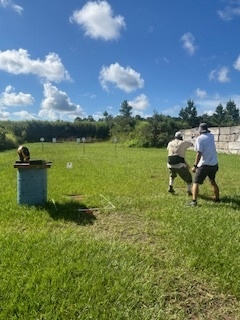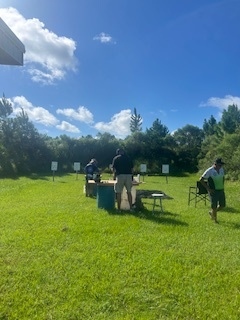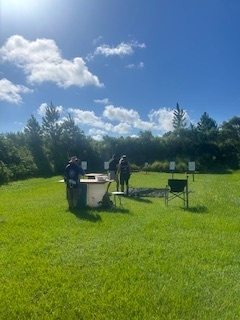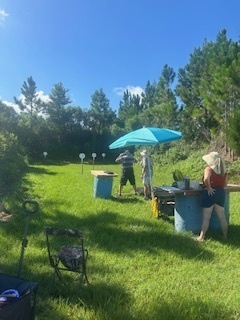

Our Club offers Steel Challenge Practice with 6 stages every Monday morning. Times can vary depending on the time of year, so check the calendar.
We also usually will run a full 8-stage Steel Challenge at least once per month.
The website for information on the Steel Challenge is https://scsa.org/
• Eye & Ear protection.
• No Magnum or Rifle Calibers allowed
• Centerfire - Holster.
• Rimfire – cased.
• Rifles- Rimfire or PCC safety flag, which is required to be in place before first stage.
• 200-300 rounds of ammunition.
• 5 magazines minimum or enough high-capacity magazines to accommodate shooting 5 times per stage.
• Read & understand Steel Challenge rules
• Established Practiscore account to register for scheduled matches.
Any Questions ask the Range Officer (RO)
Registering for the Match:
To register for a Steel Challenge match, you will need to create an account on PractiScore.com.
Steel Challenge is an exciting shooting discipline that combines speed and accuracy in a fun format that can be enjoyed by almost anyone at any level of experience.
It is important that everyone understand and follow the rules—for safety's sake and to facilitate a smooth match that's fun for everyone.
SAFETY – ALWAYS OUR FIRST PRIORITY
Hearing and eye protection is always mandatory for all participants and guests. Flagler Gun Range is a cold range:
The only time a shooter may handle a firearm is at a designated Safe Area or instructed to do so by the Range Officer [RO] in preparation for shooting a Course of Fire.
At the Safe Area, you may take your gun out of the gun bag, put it in your holster, or work on it. When not holstered, the muzzle must be pointing in a safe direction. No ammunition is allowed in the Safe Area.
All firearms are to remain unloaded at all times – no magazines, moon clips, etc., in the gun until instructed by the RO to Make Ready in preparation for shooting a Course of Fire.
You may load magazines anywhere on the range except near the Safe Area. Under no circumstances is ammunition or ammo carriers (empty or full) to be handled at the Safe Area.
No reload drills in the Safe Area.
Please read and understand all the rules before shooting Steel Challenge. If you do not follow these rules, you will be disqualified from the match for that day.
RULES: OFFICIAL RULES
SETUP
We need your help! All of our matches are only possible through volunteer help. Please come a little early to help set up the stages and stay after to help tear them down. Don't be a "Shooter Scooter."
Painting
Help paint targets. Between each shooter, the five steel targets need to be repainted. Everyone at the match – competitors and staff alike are all volunteers, so no one is paid to re-paint the targets. If you show the initiative to grab a paint can and help re-paint targets, you’ll earn a huge amount of respect from everyone at the match – even if you come in last place.
Scoring
A shooter's score is based on the total time it takes to engage and hit 5 steel plates. There are 5 strings of fire for 25 rounds per stage if there are no misses. There are four primary plates and one-stop plate set up in different arrays.
The stop plate must only be shot at the end of the string. The shooter may take as many shots as required to score hits on the plates. With no misses, a match with 6 stages will require 150 rounds—we recommend bringing 200-300, depending on your skill level.
The maximum time allowed for a string of fire is 30 seconds; most are shot in 10 seconds or less. Penalties are expressed as time added to the shooter’s performance on that string. A miss on a primary target (an unmarked plate) will incur a 3-second penalty added to the time for that string. Missing the stop plate will result in a 30-second string time.
Shooters will shoot five strings of fire, and the best four will count toward the match performance – i.e., the slowest string is thrown out. At the end of the match, all scores are added to obtain the shooter’s total match time.
Start Position
For centerfire handguns, the shooter will start with the gun loaded and holstered with wrists above the shoulders.
There is no holster for rimfire handguns or rifles, and the shooter will start aiming at a flag or Low Ready position.
How to Shoot a Steel Challenge Stage
Every stage will have a Range Officer (RO) who runs the shooters through each stage. Keep track of where you fall in the shooting order. You want to be ready with all of your magazines loaded when the RO calls your name. Bring your magazines along with your firearm (cased or holstered) to the firing line.
Range Commands
Once on the firing line, the RO will direct you by using the official range commands.
Note: 1 (specific to Flagler) you are not to enter shooters box until the RO gives you the command of, make ready.
Note: 2 Except when the competitor is actually aiming or shooting at targets, all movement must be accomplished with the fingers visibly outside the trigger guard
Make Ready
The RO’s first command is make ready! With this command, you’re authorized to do whatever it is you need to do to shoot the stage. This includes removing your firearm from the holster or case, putting a magazine in the gun, and chambering a round. If your firearm has an optic, now is the time to make sure the power is on and the dot is at the desired brightness.
You may also take a sight picture by aiming at the targets without firing if needed. This means you can hold your gun up to the targets without shooting.
When your gun is loaded and you’re ready to begin, holster your centerfire firearm and place both hands in the air in the surrender position. This signals to the RO that you’re ready. If you’re shooting from a firearm that starts from the low-ready, aim at the marker. When you do so, the RO will assume you’re ready.
Shooter Are You Ready, Standby
When the RO believes you are ready, they will ask shooter are you ready? If you’re not ready, verbally tell them. If no answer is given, the RO will then say stand by! and the next sound you hear will be the BEEP! of the timer. You may then engage the targets on the stage. When you’ve hit all five targets, the RO will read off the time from the shot timer to the scorekeeper.
During this time, you’re still under the make ready command. You can still handle your firearm and ammunition unless you are directed otherwise. You can remove the magazine (if needed) and insert a fresh one in preparation for the next string.
When you’re ready, either assume the surrender position if you’re a centerfire pistol shooter, or aim your firearm at the low-ready marker. The RO will again ask, shooter are you ready? and the cycle repeats until you have completed the stage by shooting all five strings.
Unload and Show Clear
Once you have shot all five strings, the RO gives the command if you are finished, unload and show clear. Remove the magazine from the firearm, and pull the slide or bolt back to eject any round in the chamber. Show the RO the empty chamber.
The next command will be if clear, hammer down. If you’re satisfied that your gun is unloaded, let your bolt or slide forward. Then point the firearm down range in a safe direction and pull the trigger. The hammer or striker should fall at this point, and the empty gun should have an audible click.
Rimfire shooters are not required to hammer down as pulling the trigger on some rimfires with an empty chamber can damage the firearm.
The RO will then tell you to either holster (centerfire pistols), flag and bag (rifles), or just bag (rimfire pistols). The objective is to return your firearm to the condition that it was in when you came to the firing line. Rimfire and PCC shooters need to use caution at this point. It is easy to flag or muzzle yourself when putting the firearm back in the bag. If this happens at a match, it’s a DQ. It would be a good idea to practice taking your firearm out of the case or bag and returning it there at home before the match.
Once your entire squad has completed the stage, you’ll move on as a group to the next stage. This cycle repeats until every squad have shot every stage of the match.
Getting Your Match Results
Usually within the same day the Match Director will have the scores posted to Practiscore. Typically, the Steel Challenge website uploads the scores by Wednesday of the following week. If you’ve shot a minimum of four official SCSA stages, you’ll have a classification in your chosen division.






